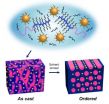(Press-News.org) "Liking" a page on the social networking site Facebook is a new form of civic engagement and humanitarian support, so concludes research published in the International Journal of Web Based Communities. According to the paper's authors social motives and an emotional response underpinned users' inclination to like, or follow, a page, rather than their simply seeking information and news.
Petter Bae Brandtzaeg and Ida Maria Haugstveit of Scandinavian research organization SINTEF in Oslo, Norway, surveyed more than 400 Facebook users about their habits on the site and their propensity to "like" a particular humanitarian cause or organization. . The Facebook like button was introduced as a feature in 2009 and allows users to both support and follow updates from a company or organization that has a Facebook presence. Additionally, liking a page is often a prerequisite for viewing information not made visible to non-subscribers and to be able to add one's own comments to the page. Moreover, depending on a user's account settings their liking of a given page will be visible to their friends and associates on the Facebook site. Unsubscribing from a given page to stop following its updates is referred to as "unliking"
The team asked 405 users questions regarding activity in order to answer three main questions: First, do Facebook users believe that liking humanitarian causes on Facebook really supports humanitarian causes? Secondly, what motivates Facebook users to like humanitarian causes? Finally, why do Facebook users unlike humanitarian causes?
The team found that there essentially six different liking practices associated with humanitarian causes with a presence on Facebook: (1) socially responsible liking; (2) emotional liking; (3) informational liking; (4) social performative liking; (6) low-cost liking; (7) routine liking.
"The majority of the respondents believe such likes help in promoting humanitarian causes," the team says. Interestingly, only a few users had unliked such causes. "It is important to note that people like a cause on Facebook because they want to support it and encourage others in their network to support it as well," the team adds. "The like button not only provides an opportunity to support a cause, but also enables users to engage with the site as a self-presentation tool." There are implications for these findings in understanding the nature and function of Facebook likes as a new form of civic engagement and humanitarian support.
"Despite the controversy about slacktivism, many Facebook users in this sample believed that 'liking' a humanitarian cause could make a difference," Brandtzaeg says. "This is strengthened by the fact that socially responsible 'liking' is the most common motivation and for the perceived motivation for liking a humanitarian cause."
INFORMATION:
Brandtzaeg, P.B. and Haugstveit, I.M. (2014) 'Facebook likes: a study of liking practices for humanitarian causes', Int. J. Web Based Communities, Vol. 10, No. 3, pp.258-279.
Humanitarian liking on Facebook
2014-06-09
ELSE PRESS RELEASES FROM THIS DATE:
Berkeley Lab researchers create nanoparticle thin films that self-assemble in 1 minute
2014-06-09
The days of self-assembling nanoparticles taking hours to form a film over a microscopic-sized wafer are over. Researchers with the U.S. Department of Energy (DOE)'s Lawrence Berkeley National Laboratory (Berkeley Lab) have devised a technique whereby self-assembling nanoparticle arrays can form a highly ordered thin film over macroscopic distances in one minute.
Ting Xu, a polymer scientist with Berkeley Lab's Materials Sciences Division, led a study in which supramolecules based on block copolymers were combined with gold nanoparticles to create nanocomposites that ...
'Hello, world!' NASA beams video from space station via laser
2014-06-09
"Hello, World!" came the message from the International Space Station as NASA successfully beamed high-definition video via laser from space to ground on Thursday, June 5. The 175-megabit video transmission was the first of its kind for the Optical Payload for Lasercomm Science (OPALS) with the goal of improving the way we receive data from orbit and beyond. In fact, this emerging technology of optical communications--or lasercomm--is likened to an upgrade from dial-up to DSL.
"It's incredible to see this magnificent beam of light arriving from our tiny payload on the ...
African-American women more likely to be diagnosed with higher risk breast cancer
2014-06-09
Washington, D.C., June 9, 2014 - A research study led by cancer specialists at MedStar Washington Hospital Center found that African-American women frequently present with biologically less favorable subtypes of breast cancer.
Researchers at the Hospital Center's Washington Cancer Institute analyzed the biology of breast cancer in 100 African-American women, using a method of genomic profiling. These genomic tests look at the expression of genes associated with the risk of recurrence in the population and further characterizes the biology of the tumor. The 70-gene MammaPrint ...
Affordable housing linked to children's test scores
2014-06-09
It's long been accepted – with little science to back it up – that people should spend roughly a third of their income on housing. As it turns out, that may be about how much a low-income family should spend to optimize children's brainpower.
Johns Hopkins University researchers have explored the effects of affordable housing on the cognitive development, physical health, and emotional wellbeing of children living in poverty. How much a family spends on housing has no impact on a child's physical or social health, they found, but when it came to cognitive ability, it ...
New study finds text messaging program benefits pregnant women
2014-06-09
WASHINGTON, DC (June 9, 2014) – The leading mobile health service in the nation, Text4baby, was found to significantly benefit pregnant women, according to a new study led by Milken Institute School of Public Health (Milken Institute SPH) at the George Washington University and the Madigan Army Medical Center. The pilot study examined several things including the short-term effects of Text4baby exposure four weeks post enrollment on attitudes, beliefs and behaviors targeted by the text messages.
"This study provides the strongest evidence to date that Text4baby reduces ...
Combined MMRV vaccine shows slight rise in adverse events
2014-06-09
The combined measles–mumps–rubella–varicella (MMRV) vaccine shows a slightly increased risk of febrile seizures in children, compared with the previously separate vaccines for MMR and varicella (chickenpox) (MMR+V), according to an article in CMAJ (Canadian Medical Association Journal).
The MMRV vaccine was developed for young children to reduce the number of needles they receive. However, the combined vaccine has been associated with slightly higher rates of febrile seizures.
Febrile seizures can accompany high fever in young children; although distressing, they are ...
Stem cells are a soft touch for nano-engineered biomaterials
2014-06-09
Scientists from Queen Mary University of London have shown that stem cell behaviour can be modified by manipulating the nanoscale properties of the material they are grown on - improving the potential of regenerative medicine and tissue engineering as a result.
Stem cells are special because they are essential to the normal function of our organs and tissues. Previous research shows stem cells grown on hard substrates go on to multiply but do not differentiate: a process by which the cells specialise to perform specific functions in the body. In contrast, stem cells ...
PET/MR is superior for verifying coronary arterial disease
2014-06-09
St. Louis, Mo. (June 9, 2014) – Ischemic heart disease, a narrowing of the arteries supplying blood to the heart, is a leading cause of death throughout the world. A hybrid molecular imaging technique called positron emission tomography and magnetic resonance (PET/MR) imaging, which tells doctors vital information about cardiac and arterial function, has been found to be an effective molecular imaging tool for detecting coronary artery disease (CAD), say researchers at the Society of Nuclear Medicine and Molecular Imaging's 2014 Annual Meeting.
Often patients suspected ...
Stem cell-stimulating therapy saves heart attack patients
2014-06-09
St. Louis, Mo. (June 9, 2014) – Researchers at the Society of Nuclear Medicine and Molecular Imaging's 2014 Annual Meeting revealed how a protein encourages the production of stem cells that regenerate damaged tissues of the heart following an acute attack (myocardial infarction). They further assert that it has a better chance of working if provided early in treatment. This was confirmed by molecular imaging, which captured patients' improved heart health after therapy.
If given after a heart attack, granulocyte colony-stimulating factor (G-CSF) mobilizes bone marrow ...
SPECT/CT reveals best treatment for low back pain
2014-06-09
St. Louis, Mo. (June 9, 2014) – Low back pain is not only excruciating but also debilitating for countless sufferers. Unfortunately, not everyone responds to treatment. A molecular imaging scan in addition to a conventional bone scan can provide the necessary information about the physiological health of the spine to select the most appropriate pain-killing treatment protocol, say researchers at the Society of Nuclear Medicine and Molecular Imaging's 2014 Annual Meeting.
Conventional imaging methods including X-ray, computed tomography and even magnetic resonance imaging ...


